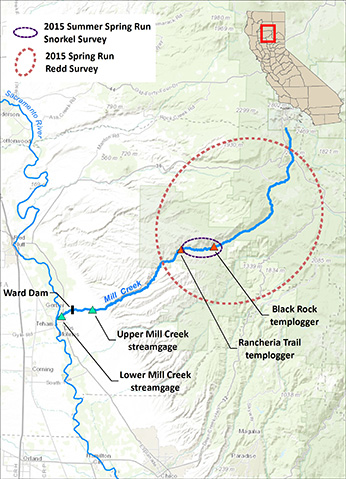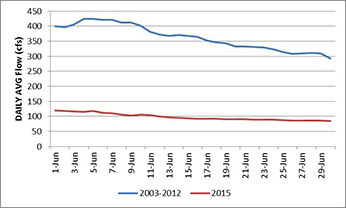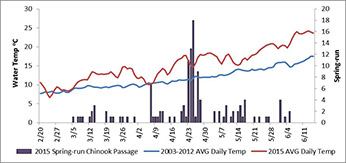(Mill Creek, Tehama County)
Species / Location
 Figure 1. CDFW monitoring spring run Chinook salmon in Mill Creek. CDFW photo.
Figure 1. CDFW monitoring spring run Chinook salmon in Mill Creek. CDFW photo.
 Figure 2. Monitoring locations on Mill Creek, Tehama County. (click/tap to enlarge)
Figure 2. Monitoring locations on Mill Creek, Tehama County. (click/tap to enlarge)
Mill Creek (Tehama County) is of one only three Central Valley streams still supporting an independent, wild population of State and Federally listed Central Valley spring-run Chinook salmon (Oncorhynchus tshawytscha) (spring-run) (Figures 1 and 2). Mill Creek is regarded as a high priority stream by California Department of Fish and Wildlife (CDFW) due to its exceptional resource value, and is considered a conservation stronghold for the Central Valley spring-run Evolutionary Significant Unit by the National Marine Fisheries Service (NMFS) (NMFS 2014). Adult spring-run enter Mill Creek between late February and early July. They quickly pass through the lower 15 miles of the creek to reach cold holding pools upstream where they mature over summer. Spawning occurs during late September to mid-October. Mill Creek's spring-run are unique among West Coast Chinook salmon populations in that they are known to spawn as high as 5,000 feet above sea level. Unlike most juvenile Chinook salmon, which begin their journey to the ocean within a few months after hatching, Mill Creek juvenile spring-run generally remain in Mill Creek for six to eighteen months. These remarkable Chinook salmon spend nearly as much of their lives in freshwater as in saltwater.
Need for Drought Stressor Monitoring
During dry years, Mill Creek agricultural water rights are in excess of available unimpaired flow. This puts agricultural practices at odds with spring-run during drought conditions, especially for adult and juvenile spring-run still migrating in late May and June. Agricultural diversions decrease available water in the last five miles of Mill Creek, making it difficult for adult spring-run to swim past shallow areas known as “critical riffles” and water diversion structures. In addition, agricultural diversions contribute to increased water temperatures, resulting in thermal stress for adult and juvenile spring-run, increased predation on juvenile spring-run, and in some cases, mortality. Careful monitoring of stream flow and water temperature (pre- and post-diversion) in Mill Creek is critical for managing the limited available water for spring-run and agriculture during the drought.
Stressor Monitoring Efforts
In 2014 and 2015, the CDFW of Fish and Wildlife (CDFW) and NMFS reached out to local water users in an effort to maintain agricultural water use while protecting the life history diversity of this unique population of spring-run during the drought. A California Endangered Species Act Memorandum of Understanding (CESA MOU) and NMFS Voluntary Drought Agreement were crafted to provide minimum protective flows in Mill Creek for spring-run. These agreements provided agricultural water users with incidental take coverage in the event spring-run were inadvertently harmed. Emergency flow regulations adopted by the California State Water Resources Control Board provided a regulatory mechanism to protect spring-run in the absence of local cooperative agreements. Figure 3 illustrates how little water was available for both spring-run and agriculture in Mill Creek in 2015, where average daily unimpaired June flow (2003-2012) is plotted against average daily June flow in 2015. Low flows, severely reduced snowpack, and above average temperatures resulted in increased water temperatures for Mill Creek’s adult spring run during the drought.
 Figure 3. Plot of average daily unimpaired Mill Creek stream flow in June for years 2003-2012 vs 2015.(click/tap to enlarge)
Figure 3. Plot of average daily unimpaired Mill Creek stream flow in June for years 2003-2012 vs 2015.(click/tap to enlarge)
 Figure 4. Plot of average daily Mill Creek water temperature 2003-2014 vs average daily water temperature in 2015, along with daily spring-run passage for the period February 20, 2015 through June 15, 2015.(click/tap to enlarge)
Figure 4. Plot of average daily Mill Creek water temperature 2003-2014 vs average daily water temperature in 2015, along with daily spring-run passage for the period February 20, 2015 through June 15, 2015.(click/tap to enlarge)
Figure 4 plots average daily water temperatures 2003-2012 versus average daily water temperature in 2015 along with daily adult spring-run passage for the period February 20, 2015 through June 15, 2015. Water temperatures in lower Mill Creek in 2015 were not optimal for adult and juvenile spring-run. However, wild salmon are very resilient creatures, and Chinook salmon from California’s Central Valley in particular are capable of persisting in less than ideal conditions. Data used in Figures 3 and 4 were obtained from the upper Mill Creek stream gage available online from the California Data Exchange website (Figure 5).
In addition to extensive real-time flow and temperature monitoring in the agriculturally diverted sections of lower Mill Creek, CDFW conducted enhanced adult spring-run monitoring in Mill Creek’s upper watershed in 2015. A video station located at Ward Dam (river mile 2.5) provided nearly real-time adult spring-run passage information. We knew how many adult spring-run had entered Mill Creek, but this marked only the beginning of their nearly 6 month residency in Mill Creek. A snorkel survey completed August 6, 2015 assessed the number and distribution of spring-run occupying the lower reaches of Mill Creeks’ spring-run summer holding habitat. There was concern that due to ongoing drought the lower range of Mill Creek’s spring-run summer holding habitat would not provide suitable thermal conditions in 2015 (Figure 6)
 Figure 5. Upper Mill Creek Stream gage. CDFW photo.
Figure 5. Upper Mill Creek Stream gage. CDFW photo.
 Figure 6. The lower reaches of Mill Creek’s spring-run Chinook salmon habitat flows through a rugged dry canyon. CDFW photo.
Figure 6. The lower reaches of Mill Creek’s spring-run Chinook salmon habitat flows through a rugged dry canyon. CDFW photo.
 Figure 7. Mill Creek spring-run Chinook salmon redd, October, 2015.
CDFW photo.
Figure 7. Mill Creek spring-run Chinook salmon redd, October, 2015.
CDFW photo.
Snorkel surveys have not traditionally been used on Mill Creek for spring-run monitoring due to Mill Creek’s naturally high turbidity. However, drought flows provided unusually clear water conditions in 2015. This created a unique opportunity to use snorkel surveys to determine the number and distribution of spring-run using Mill Creeks’ low elevation summer habitat. Finally, a spring-run redd count was completed in 2015 to assess the distribution and spawning success of spring-run in a critical drought year (Figure 7). This survey covered 34.6 river miles of spring-run spawning habitat, beginning at river mile 53 and ending at river mile 18.4.
Findings
Minimum instream flows afforded by CESA MOU and Voluntary Drought participation with agricultural water users in 2015 provided passage for an estimated 127 spring-run. Only three spring-run were observed during the August 6, 2015 snorkel survey. Although this was an extremely low population estimation compared to historical numbers, the numbers in 2015 would have been much lower without proactive flow intervention.
Additionally, through enhanced water temperature monitoring conducted by CDFW in 2015, it was determined that the lower third of Mill Creek’s spring-run holding and spawning habitat had been adversely affected by a fourth year of drought. Finally, a total of 52 completed redds were counted on the 2015 spring-run redd survey. This count demonstrates that adult spring-run migrated to suitable holding habitat in the upper watershed and experienced relatively high survival in 2015 despite less than ideal drought conditions.
Future Efforts
Mill Creek spring-run returns were exceptionally low in 2015, likely due to cumulative drought effects beginning in 2012. Ongoing enhanced of Mill Creek stream flow and water temperature is critical to ensuring that the population allowed to recover. Continued real-time monitoring of Mill Creek’s adult spring-run population will determine run-timing patterns, and response to stream flow and water temperatures. This information, along with continued cooperation of Mill Creek agricultural water users exemplified in 2015 by CESA MOU and NMFS Voluntary Drought Agreement participation, will be invaluable in providing effective protection of Mill Creek spring-run during the next California drought.
References
- Recovery Plan for the Evolutionary Significant Units of Sacramento River Winter-Run Chinook Salmon and Central Valley Spring-Run Chinook Salmon and the Distinct Population Segment of California Central Valley Steelhead. National Marine Fisheries Service West Coast Region 2014.
CDFW
NOAA Fisheries